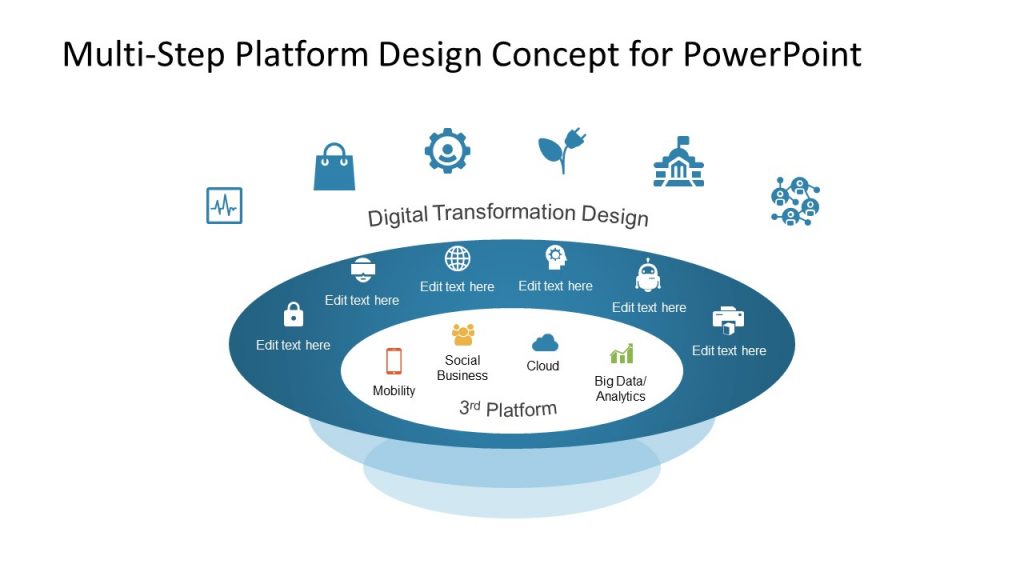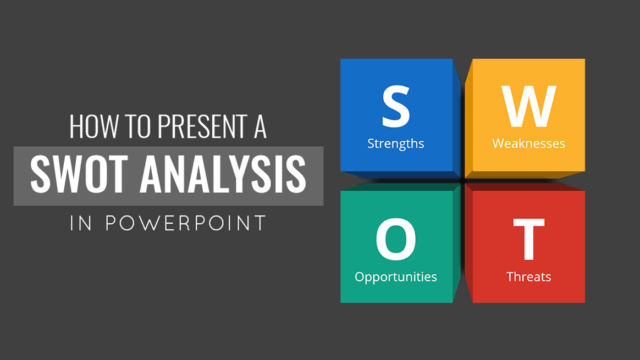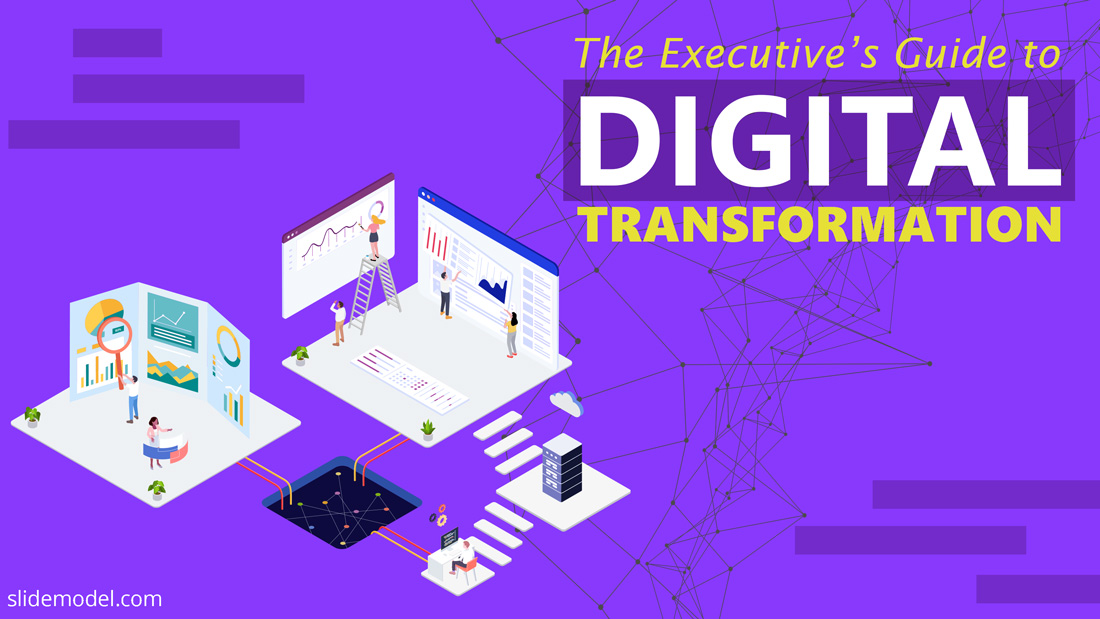
Digital transformation is a popular industry buzzword, but a difficult concept to master as it covers so much ground. As a leader, it is your responsibility to understand exactly how emerging technologies are changing the standard business processes, modern workplace and managerial best practices.
More importantly, it’s your responsibility to ensure that your organization remains competitive, and uses digital transformation as a means to grow and innovate. The following guide will define digital transformation, detail its potential, and outline ways in how it manifests across a variety of industries and can become part of your business strategy too.
- What is Digital Transformation?
- How Important The Digital Transformation Really Is?
- The Life Cycle of Digital Business Transformation Explained
- The Digital Transformation Capability Model
- Key Drivers For Digital Transformation Success
- Digital Transformation in Action
- Conclusions
What is Digital Transformation?
Think of all the business processes within your organization, the user experiences, even the culture that has been created throughout the years your company has been operating. Digital transformation can take any or all of these aspects, and re imagine them using digital technologies. In short, digital transformation equals change multiplied and amplified by technologies.
But if you want a more comprehensive digital transformation definition, here’s one proposed by George Westerman, the MIT principal research scientist:
Think of it like this: When the Disney corporation formed in 1923 it was years before computers would be commonly used in businesses. The majority of cartoons were hand-drawn by a huge team of artists. Today, instead of employing graphic artists, Disney uses cutting-edge computer technologies to create immersive viewing experiences for their fans. Moving from manual to digitized movie production has helped the company significantly accelerate their production capabilities and deliver better products and experiences to customers. Now imagine how the company would have been doing if they have still used the pencil-and-paper route?
Today, many business strategies are still backed by processes that were created ages ago (without the consideration of the potential of any sort of digital technology). Digital transformation upends that. One of the many ways companies can digitally transform their business processes is through the utilization of advanced appointment scheduling systems, which not only streamline business operations but also provide a superior customer experience.
Microsoft recently published a great video further explaining how business leaders in a variety of industries are approaching the digitization and migration towards the Industry 4.0. Satya Nadella succinctly summarizes the common vision of Digital Transformation the world’s top CEOs share: “The desire to use digital technology to change the business outcomes”.
How Important The Digital Transformation Really Is?
Digital transformation strategy is no longer a future vision. It’s something that must start happening now, and it already does with some organizations. According to Accenture, 85% of CEOs say the disruptive impact of new technologies has increased. Additionally:
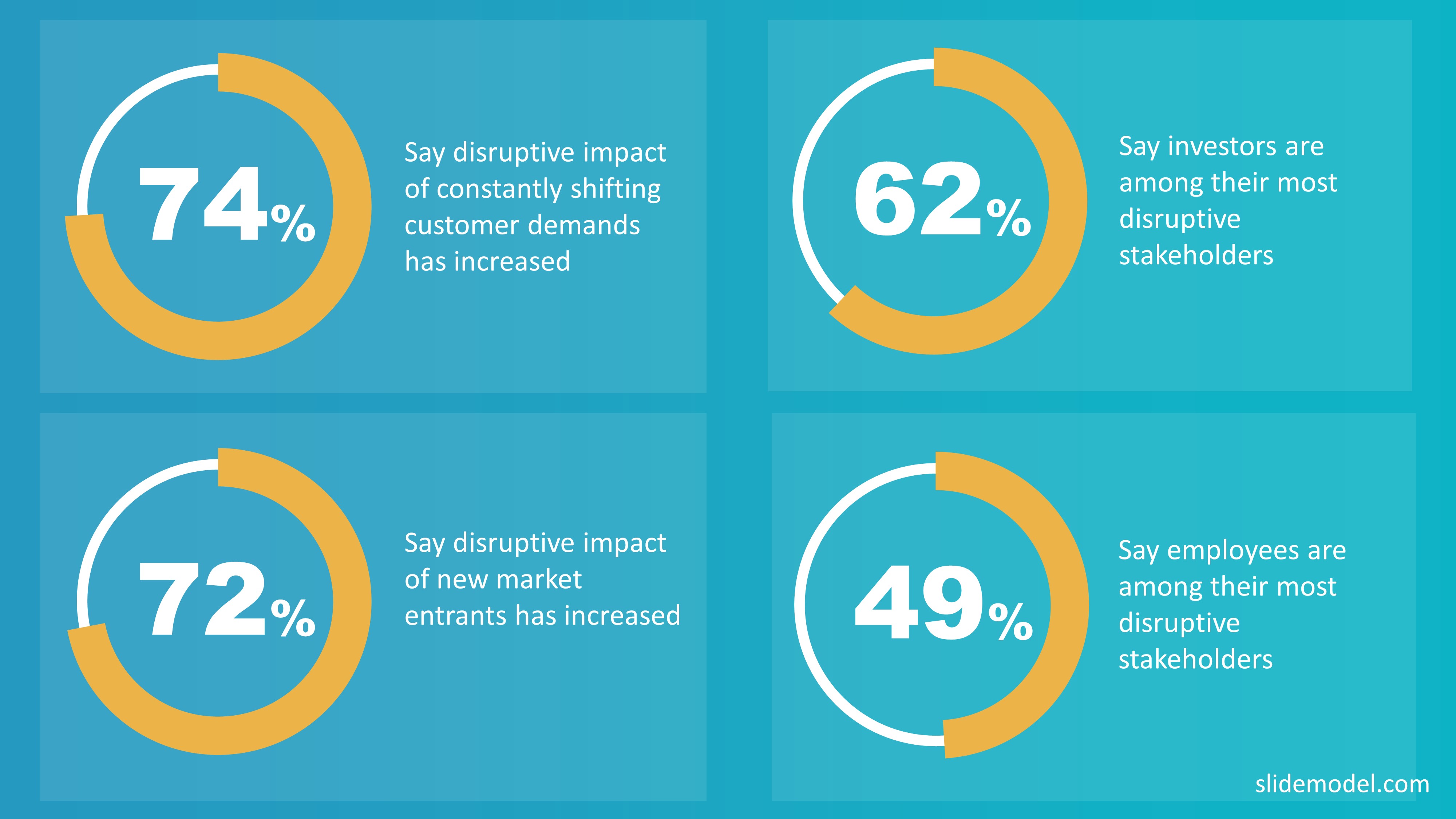
According to a recent industry survey by Progress, 85% of decision makers feel that if they do not progress with a digital transformation within the next 24 months, they will massively fall behind their competition. The wrinkle? Most of enterprise digital transformation efforts aren’t always a home run.
Per McKinsey, only 16% of survey organizations indicated that their projects resulted in improved performance, and allowed them to sustain those changes in the long term. Another 7% said that they saw the early benefits of digital transformation, but those were not sustainable.
Digital business transformation was never an easy task. But today, most companies experience high pressure to make changes if they want to remain competitive. At the same time, the digital transformational process is multi-fold and difficult. Many companies are struggling to reconcile these two aspects. That said, if you want your business to remain successful in the future, you’ll have to make a powerful leadership effort to move your company forward towards embracing the Industry 4.0.
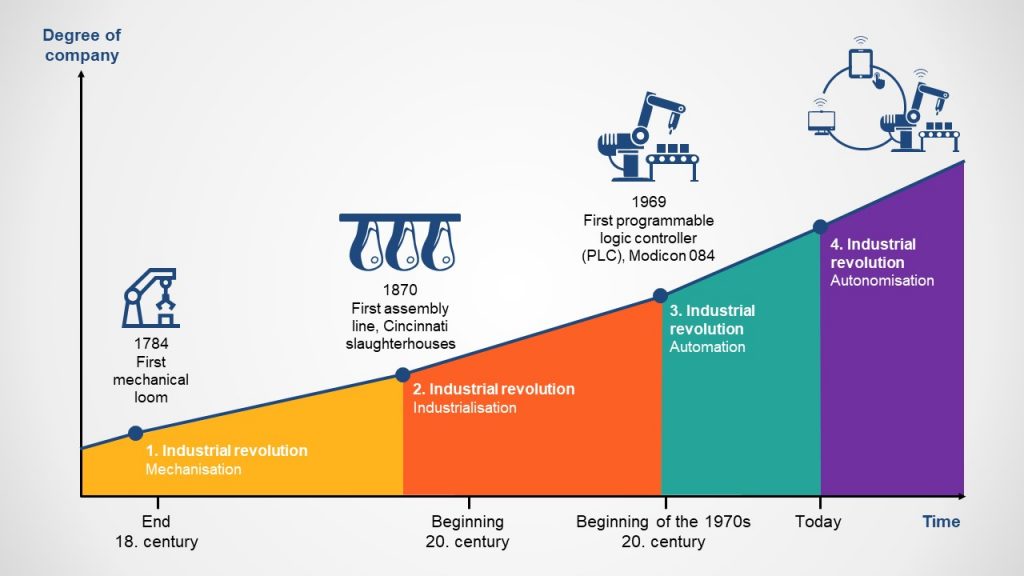
The Life Cycle of Digital Business Transformation Explained
As mentioned already digital transformation penetrates multiple business areas ranging from business process transformations and change management to reimagined business models, partnerships and relationships with customers.
Within such a complex ecosystem it’s hard to determine where exactly you should apply change if you want to get a positive business outcome. That is unless you rely on the life cycle of digital transformation model:
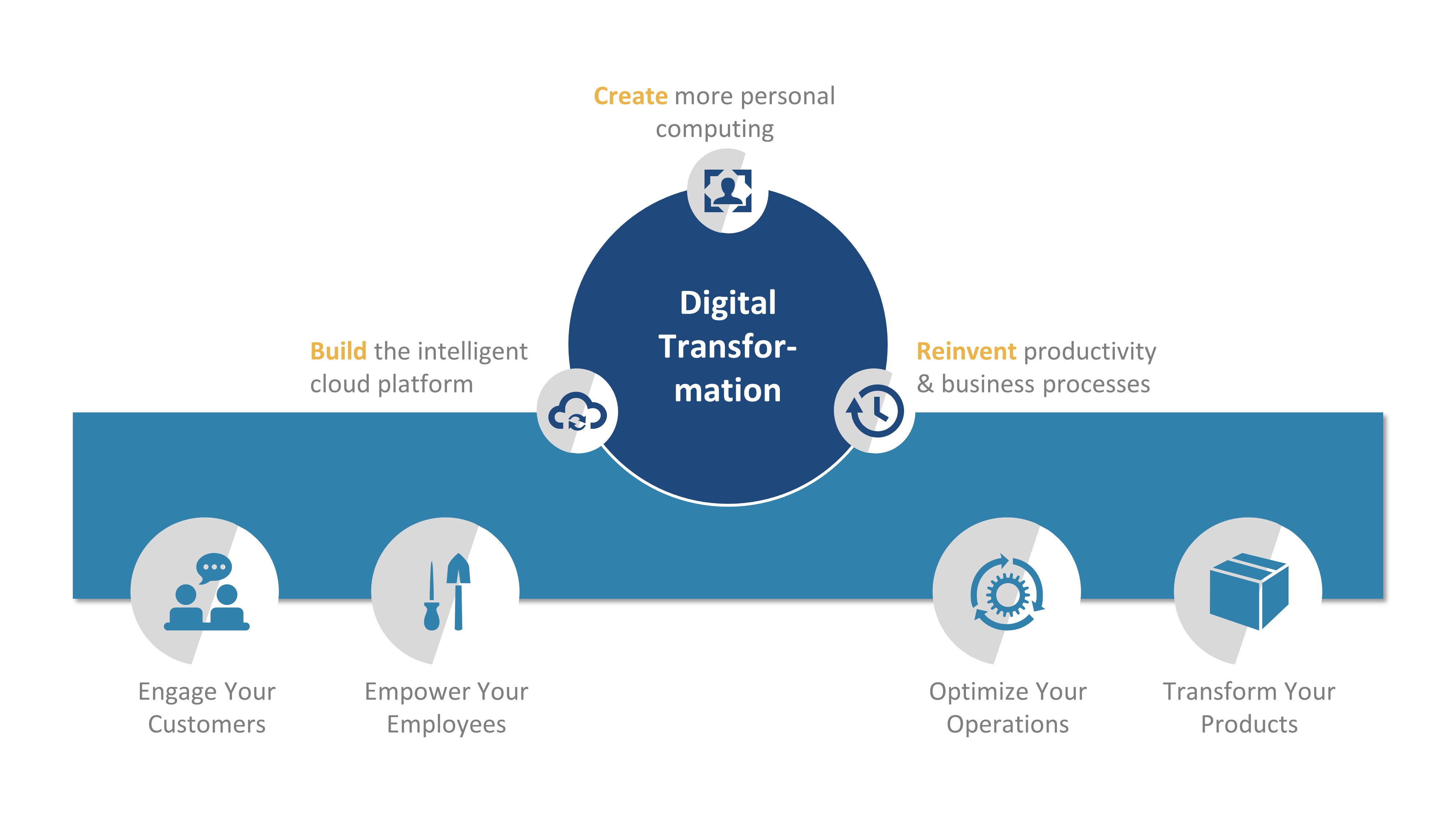
The life cycle of digital transformation represents a path your company can take to respond to market changes, new tech disruptions or regulations and respond to new customer demands. This cycle consists of three key stages.
Definition (Build)
First, you will need to develop a solid business case for transforming a certain aspect of your organization. Most companies choose to pursue digital transformation in regards to either:
- products or services offered
- business model
- value chain
Changing either of these aspects of your business will need to be properly conceptualized. That means creating and communicating the future state of the organization that you’d like to achieve, creating a list of project requirements that fully describe the scope of proposed changes and setting KPIs for measuring the progress of the implementation.
The template below illustrates exactly how businesses should approach innovations. Establishing solid, quantifiable goals is the first necessary step. Based on the stated goal and desired outcome, the company should further investigate the exact scope of change – what process must undergo the transformation. Finally, it’s worth modeling how the proposed change will impact the business and compare the risks vs rewards of pursuing it.
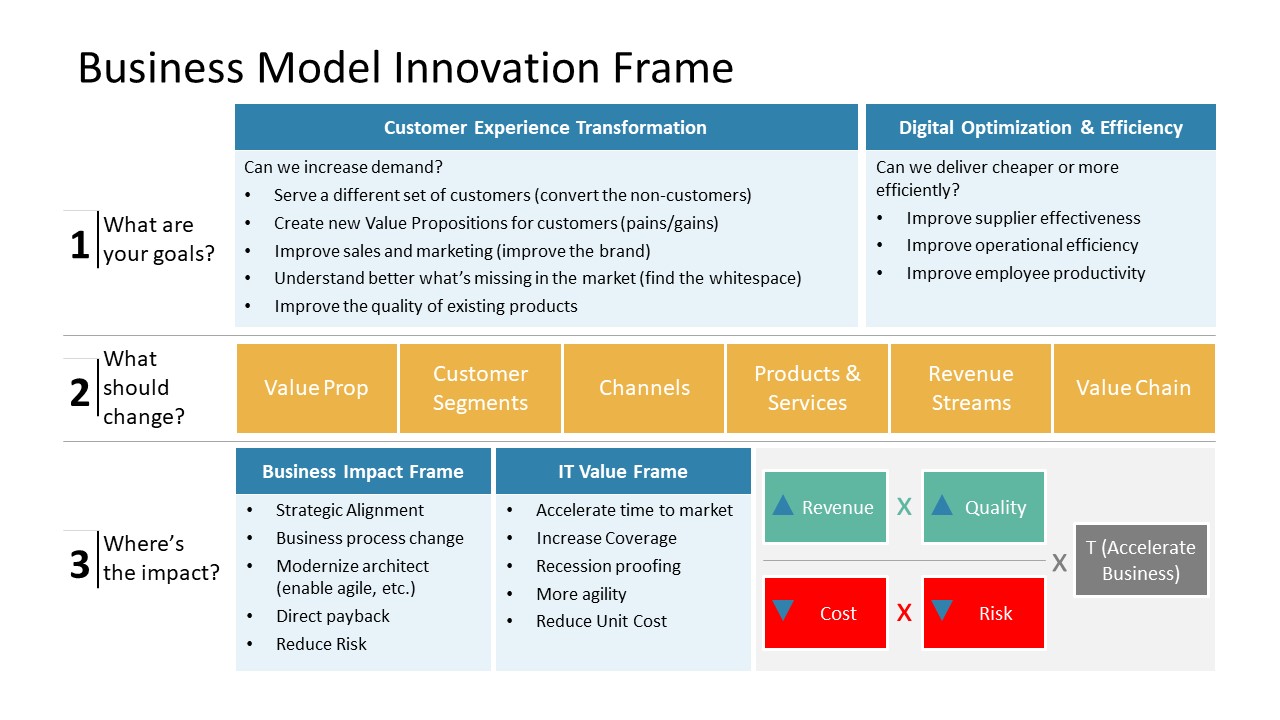
Implementation (Create)
In this phase, the new change initiative that was conceived gets implemented. In other words, you supervise and manage the development and deployment of the proposed process (or technology); educate the teams about the new solution and gradually integrate the new disruptive solution into your day-to-day business operations.
Evaluation of Achieved Value (Reinvent)
This is an ongoing monitoring practice that is put into place after implementation. At this point, you should be asking: ‘Does this new initiative meet its stated goals?’ The definite answer can be obtained through analysis and observation over time.
The first building block stage will be the most crucial one. After all, choosing the wrong course of action and overestimating your company’s capabilities to meet a certain goal can be very costly in the long run. Hence, before you make the leap, consider running a deep assessment of your digital transformation capabilities.
The Digital Transformation Capability Model
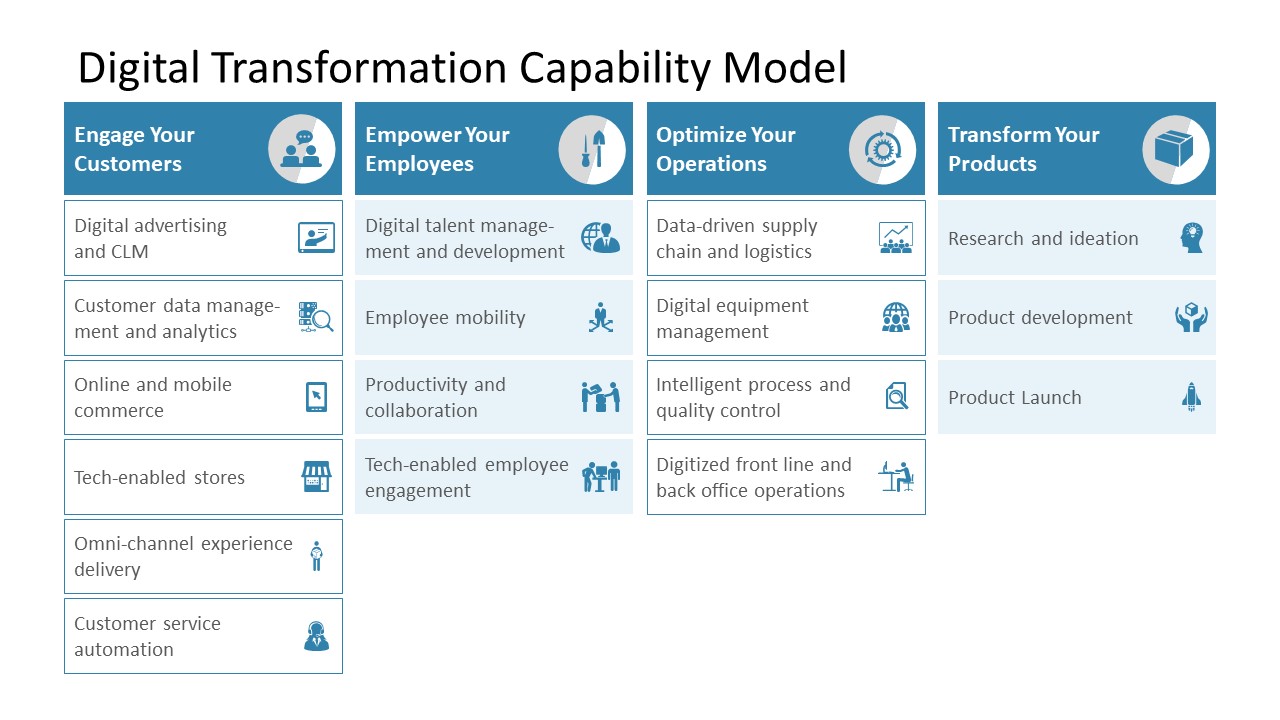
A digital capability model (framework) is a necessary part of the digital transformation journey. This model is aimed at helping you gain extra clarity and create a roadmap for smoothly moving forward with your vision. This model consists of the following four building blocks:
Digital Capabilities
Digital capabilities are the necessary skills and technologies your company needs to generate more business value and grow sustainable.
For instance, your company already uses Google Analytics to measure the effectiveness of different lead generation strategies. As well, you store customer data digitally in a CRM. Reconciling these two sources of data can potentially help you improve the success rates of your campaigns, as sales and marketing teams will gain access to a single “source of truth” and collaborate better. Using cloud technologies for data storage and perhaps adding Big Data analytics to the mix can generate a lot of additional value in that case. That is as long as doing so is relatively feasible from a technological standpoint.
So how exactly do you determine which digital capabilities are worth ramping up? Look at technologies that match either of the following requirements:
- they can improve your company’s capacity to do business online
- they can help make certain business processes more efficient and/or cost-effective
- they can make your teams more productive
- they create new business opportunities at local markets or abroad
- they enable your business to engage more effectively with the digital economy.
Digital Capabilities Maturity Model
A digital capabilities maturity model measures where your organization is in the process of becoming capable of adopting and implementing the changes that are part of your digital transformation plan.
To determine an organization’s digital maturity, Deloitte estimates its capabilities across the next five areas:
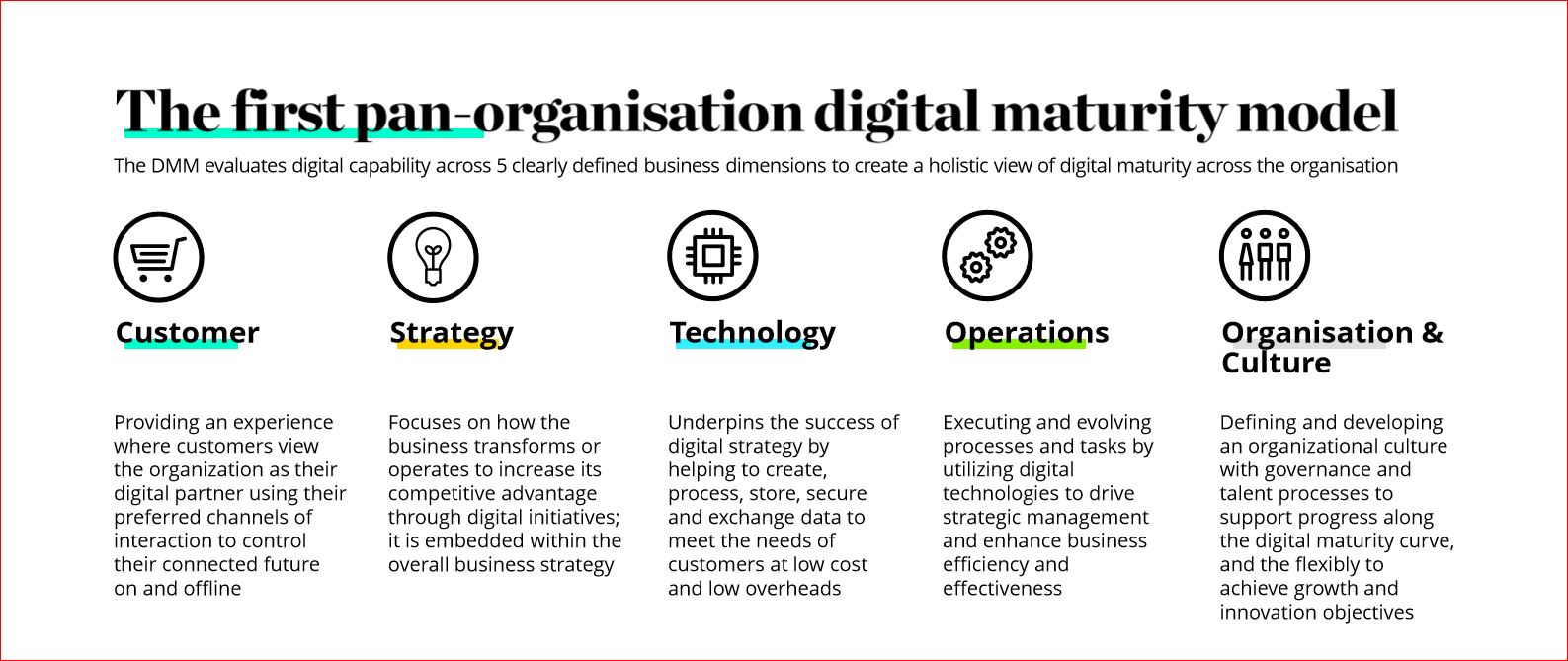 Source: Deloitte Digital Maturity Model
Source: Deloitte Digital Maturity Model
Digital Use Cases
These are particular instances where you can potentially apply new technologies to improve processes, create better customer experiences, and become a more efficient organization. For example, you might identify a way to incorporate the use of voice assistants in the process where customers place an order to improve mobile conversions.
Digital Transformation Roadmap
The digital transformation roadmap is exactly what the name applies. It is the roadmap that you create for your organization to follow as you seek to transform your organization using the digital technologies that are available to you, and that makes sense to your business model. Creating this roadmap is a key part of the digital change management process. With a clear roadmap, it becomes easier to accelerate digital transformation.
Key Drivers For Digital Transformation Success
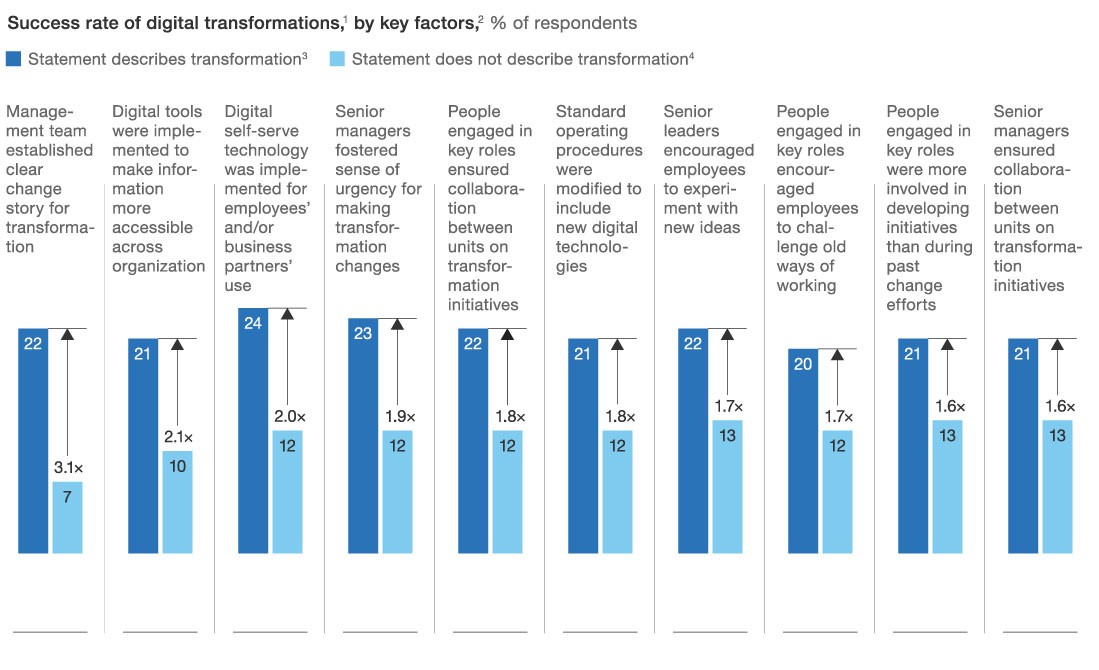 Image Credits: McKinsey&Company
Image Credits: McKinsey&Company
McKinsey has identified several drivers for success in digital transformation efforts. These are:
- Having savvy Digital Strategists & Facilitators who embrace and understand new technologies.
- Building a capable workforce who can implement and use digital technologies.
- Empowering teams to embrace technology and work in new ways.
- Ensuring that the tools that are used every day are digitally current.
- Encouraging frequent communication using both digital and traditional means of communication.
Make sure that you have all of these areas covered before launching your initiative!
Digital Transformation in Action:
Retail
Sephora recently decided to make augmented reality a key part of their digital strategy to respond to consumers’ demands for a better cosmetics shopping experience. By using Sephora’s mobile app, users can sample makeup virtually through the use of filters. Since launching their offering, the company has seen 200 million shades tried on, and over 8.5 million visits to the feature, as well as a significant improvement in sales revenues.
Healthcare
One area of innovation that is driven by digital transformation, machine learning, in particular, is a digital twin. In a nutshell, this approach allows manufacturers to create a computer-based version of a person, medical device, or another item upon which changes can be securely tested. The value in doing so is significant, as businesses investing in digital twin technology are seeing a 30% improvement in cycle times of critical processes.
Virtual and augmented reality technologies are both being implemented in the care of Alzheimer’s patients. While these technologies may not be able to cure patients, they can be used to create familiar and comforting experiences for them. This kind of innovation is creating undeniably positive outcomes when it comes to palliative care.
Banking
When it comes to IT digital transformation initiatives, banks are really focusing on Big Data. They are using it to create transformative customer experiences and devise new products such as personalized savings advice, robo-investing products and custom wealth management plans. As well as improve middle- and back-office processes:
Blockchain is another technology that is moving into the mainstream banking and financial services space. Thanks to blockchain technology banks are undergoing a digital transformation when it comes to identity verification, conducting credit checks, and using non-fiat currencies. In fact, blockchain can slash banks’ operating costs by as much as 30%.
Conclusions
At the end of the day, it does not matter which industry you are in. Digital transformations are sweeping over all sectors of the economy. Hence, companies that want to remain competitive and grow their revenues should make digital transformation initiatives a core part of their future business strategy.
Whether those initiatives are done in house or through the use of digital transformation consulting services, there is no denying that the benefits of digital transformation will pay off.
